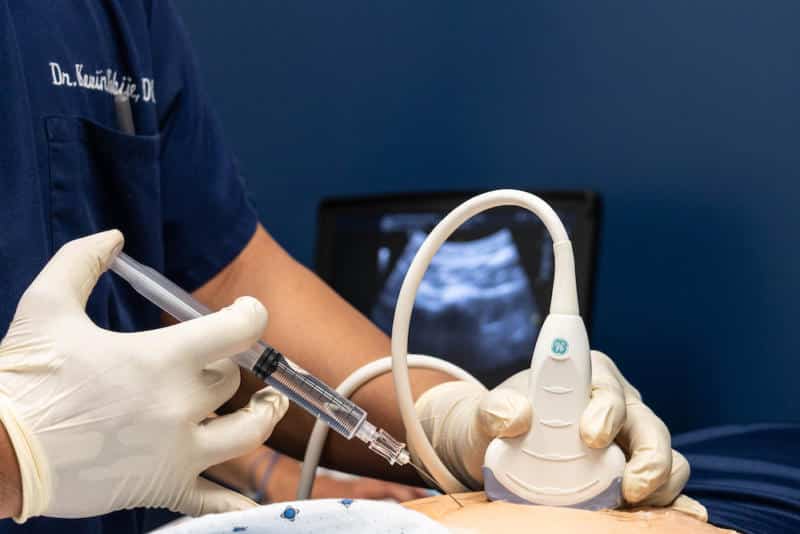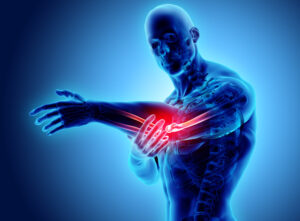Interventional (Injection based) Pain Management
At Performance Rehabilitation & Regenerative Medicine, we understand the desperation of patients in acute or chronic pain and their desire to resume an active lifestyle. Thus, the need for interventional pain management specialists as part of our inter-disciplinary team of non-surgical orthopedic specialists is paramount.
The primary goal of an interventional pain specialist is to reduce pain and/or inflammation through injection based procedures to the spine or extremity. Reduced pain levels will allow the patient to initiate physical therapy with less discomfort and ultimately return the patient to normal function and restore their quality of life. The vast majority of the interventional pain management procedures are performed in our state-of-the art medical procedural suite, which is fully equipped with video fluoroscopy and diagnostic ultrasound. We are affiliated with a local surgery center if patients wish to be sedated during a procedure.





Types of Interventional Pain Management Injections in NJ
Epidural Steroid Injection
Epidural Steroid Injection is an application of Cortisone, a powerful anti-inflammatory steroid into the area that surrounds the spinal cord and the nerves that extend from it, called the epidural space. The steroid that is injected reduces the inflammation or swelling of the nerves in the epidural space. This may reduce pain, tingling, numbness and other symptoms caused by nerve inflammation or swelling. Epidural steroid injections are a common treatment option and an integral part of the non-surgical management of sciatica, lower back, neck and arm pain.
To ensure accuracy and safety, our physician perform the procedure under fluoroscopic (x-ray) guidance to confirm needle placement. Local anesthetic and corticosteroid anti-inflammatory medication are delivered into the epidural space to shrink the swelling around nerve roots, relieving pressure and pain.
Facet Injection for Spinal Pain
If you have neck, arm, lower back or leg pain (sciatica) stemming from inflammation of the facet joints you may benefit from a facet injection. Typically it is recommended for those who fail to respond to the conservative treatments, such as oral anti-inflammatory medication, physical therapy, acupuncture or chiropractic manipulation therapy. The doctor may wish to perform the injection as a diagnostic test to determine if the facet joint is causing the pain. Facet injections may be helpful in treating inflamed facet joints caused by spinal stenosis, sciatica, spondylosis, herniated disc or arthritis.
A facet injection includes both a long-lasting corticosteroid and an anesthetic numbing agent. The drugs are delivered to the painful facet joint, either inside the joint capsule or in the tissue surrounding the joint capsule. Corticosteroid injections can reduce inflammation and can be effective when delivered directly into the painful area. Reducing the pain will allow you to improve your spinal condition with physical therapy and an exercise program.
Radio Frequency Ablation (RFA) for Spinal Pain
Radio frequency ablation (RFA) is a pain management procedure that is able to provide longer-term pain relief for chronic spinal conditions, which have not responded to more conservative interventions. Patients who are being considered for this procedure have already undergone simple injection techniques like epidural steroid injections or facet joint injections, as well as, physical therapy, chiropractic manipulation therapy, acupuncture and other more conservative treatments.
There are a multitude of chronic pain conditions that respond well to this treatment. Chronic spinal pain, including spinal arthritis (spondylosis), post-traumatic pain (whiplash), pain after spine surgery and other spinal pain conditions are those most commonly treated with RFA. A patient’s candidacy for RFA is usually determined by the performance of a diagnostic nerve block. This procedure will help to confirm the patients pain generator, which is often the spinal facet joint (facet syndrome.) Patient who have little to no pain relief after a diagnostic nerve block are not candidates for a procedure such as RFA.
Sacroiliac Joint Injection for Back and Pelvis Pain
The sacroiliac joint (SIJ) is a small, strong joint that is located below the lumbar spine and above the sacrum on both sides of the pelvis. It is a common source of low back pain and/or leg pain as it acts as a shock absorber between the lower extremity and the torso. Most cases of SIJ pain resolves with rest, physical therapy, chiropractic manipulation therapy, acupuncture or medication.
If a patient has failed conservative treatments a SIJ injection is usually warranted. A therapeutic SIJ injection provides relief by providing a strong anti-inflammatory medication to the joint (corticosteroid.) The procedure is usually done with a local anesthetic (you are conscious) and the aid of videofluoroscopy (live x-ray imagine), to ensure proper placement of the medication. After several days, the patient will usually begin or resume physical therapy to strengthen the muscles and ligaments surrounding the SIJ, for long-term relief.
Extremity/Peripheral Joint Injection
Any injection outside of the spine is referred to as an extremity or peripheral joint injection. Often the doctor at Performance Rehabilitation & Regenerative Medicine will provide an injection to a peripheral joint (shoulder, knee, hip, elbow, foot, etc.) with an anti-inflammatory medication (corticosteroids) as a way to help reduce pain and inflammation, Injection therapy is not often a cure, but a means to control pain so the patient can undergo a rehabilitative process to address the physical problem. The procedure is usually performed under local anesthesia (you are conscious), aided by computer-guided imaging. The patient is typically sore for a day or two after the procedure followed by significant relief.
Trigger Point Injection
A trigger point is an irritable, painful, taut muscle band or palpable knot in a muscle that can cause localized pain or referred pain. Referred pain from trigger points can mimic a pinched nerve in the neck or lower back. They can occur from direct muscle injuries, poor posture, repetitive strain or secondarily from spinal conditions such as herniated discs.
Trigger point injections are injections of local anesthetic medication, saline or cortisone into the trigger points. The basis for a trigger point injection is to relax the area of intense muscle spasm. By relaxing the muscle spasm, blood flow to the area is improved thus allowing the washout of irritants. Trigger point injections are an important part of treating myofascial pain syndrome and, in some cases, fibromyalgia.
Spinal Cord Stimulator Trial for Chronic Pain
At Performance Rehabilitation & Regenerative Medicine, it is our goal to help you achieve a pain-free life. When other more conservative treatments have failed to relieve your pain, our physicians may suggest a spinal cord stimulator trial.
A spinal cord stimulator generates a low-level electric field to interrupt nerve conduction of pain signals to the brain. It is a specialized device that stimulates the spinal cord and spinal nerves by emitting tiny electrical impulses via a small electrical wire placed behind and just outside the spinal cord in the epidural space.
Spinal cord stimulators are most often used for patients with chronic and sever neuropathic pain, who have not responded to other more conservative treatments. Common examples include patients with post-laminectomy nerve damage, radiculopathy, diabetic neuropathy and reflex sympathetic dystophy.
Typically, after patients have failed more conservative treatment options, consideration is given to a trial of spinal cord stimulation. Rather than put a permanent device into the patient, a temporary spinal cord stimulator wire is placed in the patient for several days. This temporary wire gives the patient an opportunity to experience spinal cord stimulation without having to undergo a full implantation. If this trial is successful in relieving pain, a permanent device can be placed under the skin.
Usually the patient who has had a trial has very good sense of success. Typically y we are looking for a significant increase in activity tolerance or a significant decrease in the need for pain medication or some combination of both.
Once the physician determines that the trial is a success, he will refer the patient to a neurosurgeon who will evaluate the patient’s condition and the outcome of the spinal cored stimulator trial and most likely implant a permanent spina cord stimulator trial and most likely implant a permanent spinal cord stimulator for continued relief.
Considering Interventional Pain Management in NJ? Contact Us.
For more information please feel free to contact one of our Patient Care Coordinators today at 908-754-1960 to make an appointment or you may book an appointment online.



















